by Calculated Risk on 1/05/2024 12:11:00 PM
Friday, January 05, 2024
Question #7 for 2024: How much will wages increase in 2024?
Earlier I posted some questions on my blog for next year: Ten Economic Questions for 2024. Some of these questions concern real estate (inventory, house prices, housing starts, new home sales), and I’ll post thoughts on those in the newsletter (others like GDP and employment will be on this blog).
I'm adding some thoughts, and maybe some predictions for each question.
7) Wage Growth: Wage growth was solid in 2023, up 4.0% year-over-year as of November, but down from 4.8% YoY in 2022. How much will wages increase in 2024?
The most followed wage indicator is the “Average Hourly Earnings” from the Current Employment Statistics (CES) (aka "Establishment") monthly employment report.
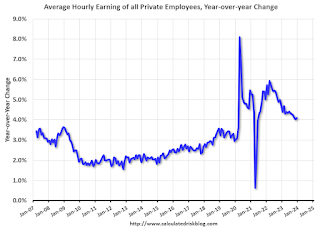
The graph shows the nominal year-over-year change in "Average Hourly Earnings" for all private employees. There was a huge increase at the beginning of the pandemic as lower paid employees were let go, and then the pandemic related spike reversed a year later.
Real wage growth has trended down after peaking at 5.6% YoY in March 2022 and was at 4.1% YoY in December 2023. Although wage growth was above expectations in December, the trend is clearly down.
There are two quarterly sources for earnings data: 1) “Hourly Compensation,” from the BLS’s Productivity and Costs; and 2) the Employment Cost Index which includes wage/salary and benefit compensation. All three data series are different, and most of the focus recently has been the CES series (used in the graph above).
 The second graph is from the Atlanta Fed Wage Tracker. This measure is the year-over-year change in nominal wages for individuals.
The second graph is from the Atlanta Fed Wage Tracker. This measure is the year-over-year change in nominal wages for individuals.By following wage changes for individuals, this removes the demographic composition effects (older workers who are retiring tend to be higher paid, and younger workers just entering the workforce tend to be lower paid).
The Atlanta Fed Wage tracker showed nominal wage growth increased sharply in 2021 and for most of 2022. In November 2023, the smoothed 3-month average wage growth was at 5.2% year-over-year, down from a peak of 6.7% in July 2022.
Clearly wage growth is slowing and I expect to see some further decreases in both the Average hourly earnings from the CES, and in the Atlanta Fed Wage Tracker. My sense is nominal wages will increase close to 3.5% YoY in 2024 according to the CES.
Here are the Ten Economic Questions for 2024 and a few predictions:
• Question #1 for 2024: How much will the economy grow in 2024? Will there be a recession in 2024?
• Question #2 for 2024: How much will job growth slow in 2024? Or will the economy lose jobs?
• Question #3 for 2024: What will the unemployment rate be in December 2024?
• Question #4 for 2024: What will the participation rate be in December 2024?
• Question #5 for 2024: What will the YoY core inflation rate be in December 2024?
• Question #6 for 2024: What will the Fed Funds rate be in December 2024?
• Question #7 for 2024: How much will wages increase in 2024?
• Question #8 for 2024: How much will Residential investment change in 2024? How about housing starts and new home sales in 2024?
• Question #9 for 2024: What will happen with house prices in 2024?
• Question #10 for 2024: Will inventory increase further in 2024?
Comments on December Employment Report
by Calculated Risk on 1/05/2024 09:26:00 AM
The headline jobs number in the December employment report was above expectations, however employment for the previous two months was revised down by 71,000, combined. The participation rate and the employment population ratio both decreased, and the unemployment rate was unchanged at 3.7%.
Seasonal Retail Hiring
Typically, retail companies start hiring for the holiday season in October, and really increase hiring in November. Here is a graph that shows the historical net retail jobs added for October, November and December by year.
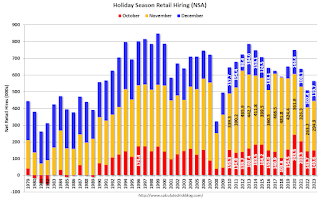 This graph really shows the collapse in retail hiring in 2008. Since then, seasonal hiring had increased back close to more normal levels. Note: I expect the long-term trend will be down with more and more internet holiday shopping.
This graph really shows the collapse in retail hiring in 2008. Since then, seasonal hiring had increased back close to more normal levels. Note: I expect the long-term trend will be down with more and more internet holiday shopping.Retailers hired 120 thousand workers Not Seasonally Adjusted (NSA) net in December. This was above last year.
Prime (25 to 54 Years Old) Participation
 Since the overall participation rate is impacted by both cyclical (recession) and demographic (aging population, younger people staying in school) reasons, here is the employment-population ratio for the key working age group: 25 to 54 years old.
Since the overall participation rate is impacted by both cyclical (recession) and demographic (aging population, younger people staying in school) reasons, here is the employment-population ratio for the key working age group: 25 to 54 years old.The 25 to 54 years old participation rate declined in December to 83.2% from 83.3% in November, and the 25 to 54 employment population ratio declined to 80.4% from 80.7% the previous month.
Average Hourly Wages
 The graph shows the nominal year-over-year change in "Average Hourly Earnings" for all private employees from the Current Employment Statistics (CES).
The graph shows the nominal year-over-year change in "Average Hourly Earnings" for all private employees from the Current Employment Statistics (CES). Wage growth has trended down after peaking at 5.9% YoY in March 2022 and was at 4.1% YoY in December.
Part Time for Economic Reasons
 From the BLS report:
From the BLS report:"The number of persons employed part time for economic reasons, at 4.2 million, changed little in December but was up by 333,000 over the year. These individuals, who would have preferred full-time employment, were working part time because their hours had been reduced or they were unable to find full-time jobs."The number of persons working part time for economic reasons decreased in December to 4.21 million from 3.99 million in November. This is at pre-recession levels.
These workers are included in the alternate measure of labor underutilization (U-6) that increased to 7.1% from 7.0% in the previous month. This is down from the record high in April 2020 of 23.0% and up from the lowest level on record (seasonally adjusted) in December 2022 (6.5%). (This series started in 1994). This measure is close to the 7.0% level in February 2020 (pre-pandemic).
Unemployed over 26 Weeks
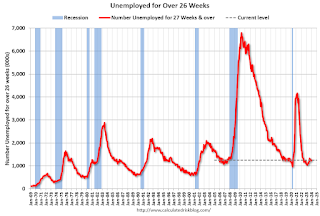 This graph shows the number of workers unemployed for 27 weeks or more.
This graph shows the number of workers unemployed for 27 weeks or more. According to the BLS, there are 1.245 million workers who have been unemployed for more than 26 weeks and still want a job, up from 1.220 million the previous month.
This is close to pre-pandemic levels.
Job Streak
| Headline Jobs, Top 10 Streaks | ||
|---|---|---|
| Year Ended | Streak, Months | |
| 1 | 2019 | 100 |
| 2 | 1990 | 48 |
| 3 | 2007 | 46 |
| 4 | 1979 | 45 |
| 5 | 20231 | 36 |
| 6 tie | 1943 | 33 |
| 6 tie | 1986 | 33 |
| 6 tie | 2000 | 33 |
| 9 | 1967 | 29 |
| 10 | 1995 | 25 |
| 1Currrent Streak | ||
Summary:
The headline monthly jobs number was above consensus expectations; however, employment for the previous two months was revised down by 71,000, combined. The participation rate and the employment population ratio both decreased, and the unemployment rate was unchanged at 3.7%.
December Employment Report: 216 thousand Jobs, 3.7% Unemployment Rate
by Calculated Risk on 1/05/2024 08:30:00 AM
From the BLS:
Total nonfarm payroll employment increased by 216,000 in December, and the unemployment rate was unchanged at 3.7 percent, the U.S. Bureau of Labor Statistics reported today. Employment continued to trend up in government, health care, social assistance, and construction, while transportation and warehousing lost jobs.
...
The change in total nonfarm payroll employment for October was revised down by 45,000, from +150,000 to +105,000, and the change for November was revised down by 26,000, from +199,000 to +173,000. With these revisions, employment in October and November combined is 71,000 lower than previously reported.
emphasis added
 Click on graph for larger image.
Click on graph for larger image.The first graph shows the jobs added per month since January 2021.
Payrolls for October and November were revised down 71 thousand, combined.
 The second graph shows the year-over-year change in total non-farm employment since 1968.
The second graph shows the year-over-year change in total non-farm employment since 1968.In December, the year-over-year change was 2.70 million jobs. Employment was up solidly year-over-year but has slowed closer to more normal levels of job growth recently.
The third graph shows the employment population ratio and the participation rate.
 The Labor Force Participation Rate decreased to 62.5% in December, from 62.8% in November. This is the percentage of the working age population in the labor force.
The Labor Force Participation Rate decreased to 62.5% in December, from 62.8% in November. This is the percentage of the working age population in the labor force. The Employment-Population ratio decreased to 60.1% from 60.4% (blue line).
I'll post the 25 to 54 age group employment-population ratio graph later.
 The fourth graph shows the unemployment rate.
The fourth graph shows the unemployment rate. The unemployment rate was unchanged at 3.7% in December from 3.7% in November.
This was above consensus expectations; however, October and November payrolls were revised down by 71,000 combined.
Thursday, January 04, 2024
Friday: Employment Report
by Calculated Risk on 1/04/2024 07:31:00 PM
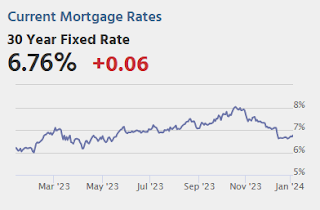
Friday:
• At 8:30 AM ET, Employment Report for December. The consensus is for 158,000 jobs added, and for the unemployment rate to increase to 3.8%.
• At 10:00 AM, the ISM Services Index for December
December Employment Preview
by Calculated Risk on 1/04/2024 01:27:00 PM
On Friday at 8:30 AM ET, the BLS will release the employment report for December. The consensus is for 158,000 jobs added, and for the unemployment rate to increase to 3.8%.
There were 199,000 jobs added in November, and the unemployment rate was at 3.7%.
From Goldman Sachs:
"We expect an above-consensus 190k increase in payrolls and a below-consensus 3.7% unemployment rate on Friday."• ADP Report: The ADP employment report showed 164,000 private sector jobs were added in December. This suggests job gains above consensus expectations, however, in general, ADP hasn't been very useful in forecasting the BLS report.
• ISM Surveys: Note that the ISM services are diffusion indexes based on the number of firms hiring (not the number of hires). The ISM® manufacturing employment index increased in December to 48.1%, down from 45.8% last month. This would suggest about 30,000 jobs lost in manufacturing. The ADP report indicated 13,000 manufacturing jobs lost in December.
The ISM® services employment index will be released after the employment report on Friday.
• Unemployment Claims: The weekly claims report showed a smaller number of initial unemployment claims during the reference week (the 3rd through the 9th in December) from 203,000 in November to 235,000 in December. This suggests fewer layoffs in December compared to November.
Asking Rents Mostly Unchanged Year-over-year
by Calculated Risk on 1/04/2024 10:01:00 AM
Today, in the Real Estate Newsletter: Asking Rents Mostly Unchanged Year-over-year
Brief excerpt:
Here is a graph of the year-over-year (YoY) change for these measures since January 2015. Most of these measures are through November 2023, except CoreLogic is through October and Apartment List is through December 2023.There is much more in the article.
The CoreLogic measure is up 2.5% YoY in October, down from 2.6% in September, and down from a peak of 13.9% in April 2022.
The Zillow measure is up 3.3% YoY in November, mostly unchanged from 3.2% YoY in October, and down from a peak of 16.1% YoY in March 2022.
The ApartmentList measure is down 1.0% YoY as of December, up from -1.1% in November, and down from a peak of 18.2% YoY November 2021.
...
OER and CPI shelter will decline further in the CPI release next week.
Weekly Initial Unemployment Claims Decrease to 202,000
by Calculated Risk on 1/04/2024 08:30:00 AM
The DOL reported:
In the week ending December 30, the advance figure for seasonally adjusted initial claims was 202,000, a decrease of 18,000 from the previous week's revised level. The previous week's level was revised up by 2,000 from 218,000 to 220,000. The 4-week moving average was 207,750, a decrease of 4,750 from the previous week's revised average. The previous week's average was revised up by 500 from 212,000 to 212,500.The following graph shows the 4-week moving average of weekly claims since 1971.
emphasis added
 Click on graph for larger image.
Click on graph for larger image.The dashed line on the graph is the current 4-week average. The four-week average of weekly unemployment claims decreased to 207,750.
The previous week was revised up.
Weekly claims were above the consensus forecast.
ADP: Private Employment Increased 164,000 in December
by Calculated Risk on 1/04/2024 08:15:00 AM
Private sector employment increased by 164,000 jobs in December and annual pay was up 5.4 percent year-over-year, according to the December ADP® National Employment ReportTM produced by the ADP Research Institute® in collaboration with the Stanford Digital Economy Lab (“Stanford Lab”). The ADP National Employment Report is an independent measure and high-frequency view of the private-sector labor market based on actual, anonymized payroll data of more than 25 million U.S. employees.This was above the consensus forecast of 130,000. The BLS report will be released Friday, and the consensus is for 158 thousand non-farm payroll jobs added in November.
...
“We're returning to a labor market that's very much aligned with pre-pandemic hiring,” said Nela Richardson, chief economist, ADP. “While wages didn't drive the recent bout of inflation, now that pay growth has retreated, any risk of a wage-price spiral has all but disappeared.”
emphasis added
Wednesday, January 03, 2024
Thursday: ADP Employment, Unemployment Claims
by Calculated Risk on 1/03/2024 08:14:00 PM

Thursday:
• At 8:15 AM ET, The ADP Employment Report for December. This report is for private payrolls only (no government). The consensus is for 130,000, up from 103,000 jobs added in November.
• At 8:30 AM, The initial weekly unemployment claims report will be released.
Vehicles Sales increase to 15.83 million SAAR in December; Up 17% YoY
by Calculated Risk on 1/03/2024 06:00:00 PM
Wards Auto released their estimate of light vehicle sales for December: December U.S. Light-Vehicle Sales Hit 5-Month High; Entire 2023 Totals 4-Year Best 15.5 Million (pay site).
Labor-related plant shutdowns in the U.S. that covered the latter half of September and most of October negatively impacted deliveries in November. Combined sales of the vehicles impacted by shutdowns fell 15% year-over-year in November. If those vehicles had matched year-ago results, sales would have totaled a 15.9 million-unit SAAR. While CUVs accounted for over half the market for the second time ever, vehicles impacted by the strikes were largely behind weakness in pickups, SUVs and vans.
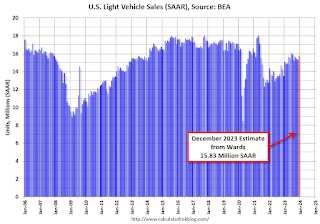 Click on graph for larger image.
Click on graph for larger image.This graph shows light vehicle sales since 2006 from the BEA (blue) and Wards Auto's estimate for December (red).
Sales in December were up 3.3% from November, and up 16.8% from December 2022.
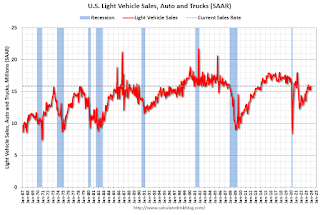 Vehicle sales are usually a transmission mechanism for Federal Open Market Committee (FOMC) policy, although far behind housing. This time vehicle sales were more suppressed by supply chain issues and are up year-over-year.
Vehicle sales are usually a transmission mechanism for Federal Open Market Committee (FOMC) policy, although far behind housing. This time vehicle sales were more suppressed by supply chain issues and are up year-over-year.Sales in December were above the consensus forecast.


